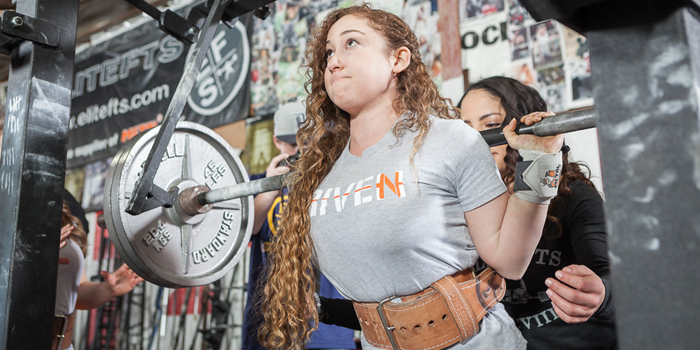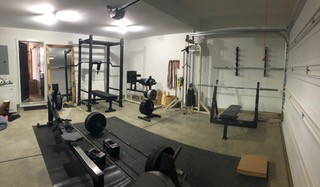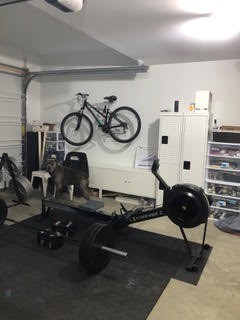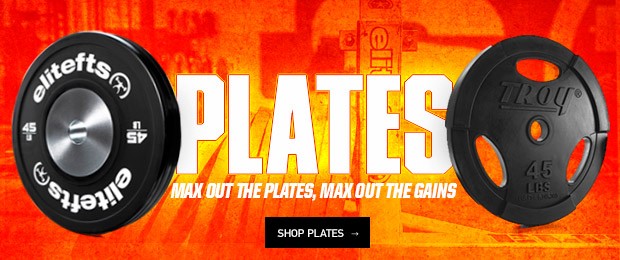
I know I’m normally one to write articles covered in scientific references. However, this month I wanted to write about something near and dear to my heart: How to put together your own garage gym. For anyone that knows me, you know that training is basically what keeps me sane and acting (mostly) professional. So, it should be no surprise that this past winter when I moved into my first house with a garage, that plans for making a garage gym went into full effect.
RECENT: Hard Lessons Learned From Half a Lifetime of Lifting
Whereas some people see their garage as a place to store crap they don't want to unpack, I saw it as a place where I could be free of other people being annoying in the gym. A place where I could train in solitude, a place where I could pet the pups between sets, and a place where I didn't have to look for parking or wait for squat racks to free up. And so, I’m going to change it up and talk to you about how to set up a garage gym of your own, what I’ve come to learn in the process of setting up ours, and how you can do it without breaking the bank.
I’d like to think this gym is set up for a powerlifter, who also still needs to store some things without it looking messy. That means I’m not just going to cover what’s in the gym that can be used for training, but also what’s in there to keep things looking nice. To add some extra storage to the home gym and to make it look nice and bright, we painted the garage white and then threw some white lockers against one side of the garage so they could blend while being functional.

We also added two deformable LED garage lights with adjustable panels from Amazon. I highly suggest all garage gym owners look into getting these because they are cheap but make the garage really well lit. Additionally, to make the place look bigger than it is, we also threw in a couple of floor to ceiling mirrors (framed in Texas squat bar pallets). Finally, to keep things from getting messy, we set up a few wicker baskets to store handle attachments, foam rollers, yoga mats, knee and elbow sleeves, and cleaning supplies. Keeping things off the ground makes the place look neat and thus, larger. But those are just the small details. What about what’s actually in the gym.
We have the following, which I think are essential:
1. Power rack: So you can train. That one I hope is obvious.
2. Wall mounted horizontal 6 bar storage: Because you need every inch of floor space.
3. Olympic bar or power bar: Personally, if you do zero Olympic lifts, I would go with a good power bar that you can use to bench and squat with. If you do Olympic lifts, then go with an Olympic bar since you can also squat and bench with it.
4. Texas deadlift bar: I hate to say this, but after a long time of training with and without one, I’ve come to find them to be essential. They just make deadlifting so much more enjoyable.
5. Safety squat bar: I just love this bar, that’s why. It’s the crusher of weaknesses. Also, it makes your triceps feel lovely if you use it for JM presses.
6. A barbell for rack pulls: I don't believe a squat or bench bar should be rack pulled with. You need a bar that you don’t worry about because if you train with strong enough people who rack pull, it will eventually get some dings/bends.
7. Plate trees: Honestly, this or plate storage on the rack works. You need one or the other. You can get a used one for about 20 bucks, or for free if you have a welder friend. It keeps the walls of your garage from being covered in plate marks.
8. Lots of plates and bumpers: I think this one is obvious.
9. Lots of bands: So you can do all those exercises you would do on machines.
10. Wood blocks: So you can do lots of block pulls and deficit deadlifts.
11. Wood box: So you can do box squats and step-ups.
12. Powerblock elite dumbbells: They are a huge space and money saver. Plus, once you get used to them, they feel better than regular dumbbells.
13. A bench with a fatpad: Why you need a bench is pretty obvious: To bench, do Bulgarians, dips, etc. However, why the fat pad? Because it just feels way more stable than a regular bench.
14. Horse stall mats: You need these so you don’t break the concrete on your floor.
15. Sandpaper and oil: In a garage gym, your bars are more likely to rust than in a climate controlled commercial gym. So it’s IMPORTANT you take care of them and prevent rust by sandpaper and oiling them.
The following are not essential, but great to have:
1. Competition bench: It wasn’t a need since you can bench in the rack, but it is really nice to have an area to just bench without having foot placement restricted by the size of the power rack.
2. A GHR: I really think having this or a reverse hyper for posterior chain development. With the GHR you can also use it as a back extension.
3. Half of a cable crossover and lots of handle attachments: It’s not a need, because you can do pull-ups, barbell rows, and use bands to re-create most of the movements done on here, but damn do I love it.
4. 1, 2, 3 boards: So you can work different ranges of motion on your bench.
5. Kettlebells: Great for cardio, strength, and endurance-based exercises.
6. Weight vest: For rucking and adding weight to bodyweight exercises.
7. A rower: A great present to help supplement my normal cardio of outdoor runs and rucks.
8. Wireless speaker: Because who doesn’t like to make training sessions a party.
9. Diffuser: Because the horse stall mats you put in your garage will smell like rubber if you don’t run one.

Things the gym still needs:
1. Cambered bar: Because I really love squatting with this bar (or a bow bar). And I love the added range of motion you get when you bench with it.
2. Dip attachment for power rack: Because you can never have too much tricep.
3. 0-90 degree bench: Because it’s way more stable then propping the regular bench up on a box-induced incline.
4. A deadlift jack: Because when there is a 200-pound difference between the weight you need to pull and your training partner needs to pull, it’s miserable to change weights every other set without one.
Setting this gym up was a workout in itself. It required cleaning all boxes out of the garage and then installing everything. And while I don’t think some of the things we have you necessarily need, it’s what ended up working for us. For example, if we hadn’t lucked out and literally gotten a very old, but in very good condition, competition bench for $50, I think all benching would happen in the rack.
I think it’s always nice to have some piece of cardio equipment, but I also believe that your two feet are free ninety-nine, so if you are on a budget no need to put cardio equipment in your garage gym. That being said, I do love the Concept2 rower and I’m happy it worked out so we could have one, but I digress. And since this is an article about getting garage gyms set up, I’m now going to share some lessons I learned from setting up ours.
Lesson 1: Some things you absolutely need to spend the money on.
For those that don’t know, I also HATE to spend money but love nice things. However, when we decided to start purchasing gym equipment, we were in agreement that there were some things we couldn't skimp on. In my perfect world, every piece of equipment would have come from elitefts because even if I didn't write for them, I believe the products are the best on the market. So, what matters is quality bars to bench, squat, and deadlift with and a quality bench to bench on. The fact those things matter to me now makes me laugh because I think it makes me barbell bougie. Having a good rack matters big time, too. These are the things you just can’t skimp on.
Lesson 2: Facebook marketplace.
Let me tell you, for as much as I dislike Facebook marketplace, it can be a great place to get things for cheap. For example, new plates go for about two dollars a pound. When you do the math that can get pricey, fast. However, on Facebook marketplace, you can find people who decided they are done training and are selling plates in decent condition for around a dollar a pound. Sure, it requires you to drive to those people, inspect the stuff (which often isn’t as advertised), and then get it home. But if you are willing to put in the time and work, you can get weight for half the price of new plates.
RELATED: Why I Bought From elitefts
Sometimes, you can even find used Powerblock dumbbells, rowers, kettlebells, and other gym equipment in decent shape. So when you’re on a budget, and are okay compromising quality, Facebook marketplace can be a clutch place to pick up some nonessentials and extra weight for your gym. In our garage gym, we got an extra 195 pounds and a weight tree for $110 (in excellent condition) from some former Westside lifters. Basically, a steal!
Lesson 3: Have friends who are handy and friends who are strong.
Honestly, if our friend Marcus hadn’t helped us with the gym, I think we wouldn't have quite the setup we have now. Marcus is great and the whole reason we have half a cable crossover (a whole one doesn't fit in a garage), is because he sawed one in half for us! Friends like this and those who can weld can really help make or break the stuff that goes into a home gym.
Similarly, friends who can build things like blocks to pull from and boxes to squat on are also great to have. Lastly, assembling the home gym takes more muscle than one person alone has. Because of this, having friends that can help you move in the heavy equipment really makes a world of difference. It makes it go from a tiring process, to a fun one. Just make sure you pay them for their help in cookies, training sessions, beers, or good times and laughs.
Having a garage gym is really one of the greatest things. Getting it set up can be a pain, but it’s worth it! So, when you get started on making yours remember to spend on the important stuff, save on the less important stuff and enjoy the heck out of your opportunity to have a home gym!











1 Comment